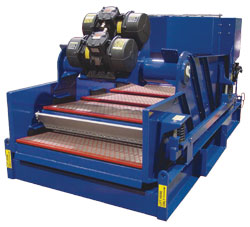|
Vol. 226 No. 12 |
| |
 |
Rig Floor Equipment
King Cobra II offers automatic shaker control
Solids control has long been recognized as a significant part of any drilling program. Operators place great value on solids control equipment as part of the rig selection process. Drilling and mud engineers agree that the shale shaker is the most important piece of equipment in solids control. Consequently, solids control equipment manufacturers have responded within the last 25 years with a steady stream of constant upgrades focused on fine screening at the flowline. However, having a well designed shaker, proper rig-up and properly maintained shakers is only part of the battle. Execution of the shaker operation and screen selection is directly related to the derrick man’s experience and work habits.
 |
The proprietary King Cobra II was designed with dual-motion capabilities.
|
|
Adding automation to a shale shaker increases the probability of maximizing screen performance and increasing solids control efficiency. Even the most experienced and conscientious derrick man has learned that pushing the limits of the shaker’s capacity is living on the edge, particularly as the industry raises the bar on environmental responsibility and tighter regulation. Until automated shaker controls (ASCs) became a reality, a safer or more conservative approach to screen selection was a sound strategy. However, screening aggressively is not the only advantage. There are many values and purposes for developing ASCs on the King Cobra from National Oilwell Varco subsidiary, Brandt.
Shale shakers have traditionally been manually operated machines. Basket angles are either fixed or manually adjustable. Recently, pushbutton controls have become more common. Acceleration is also fixed or, in some cases, manually adjustable. These features tend to cause problems with screen life, flow capacity, operator intervention and increased HSE exposure.
Sensors have been added above the first screen to measure the fluid level in the basket. Additional sensors measure incoming flowrate and the basket angle. An onboard computer controls the basket angle to place the fluid near the optimum position in the basket. An improved fluid-profile, mud covering the screen surface, improves screen life significantly. The automatic basket angle capability also results in less operator intervention. The derrickman is not as restricted to watching shakers and can focus on other responsibilities.
As the screen capacity is challenged in changing conditions, the basket automatically adjusts to a more uphill position, which maintains a constant fluid level and protects against mud losses. As the demand on the shaker is decreased, the basket automatically adjusts to a more downhill position, which keeps the screens mud-covered and well lubricated. Throughout the changing demands on the shaker, the fluid-end point remains constant.
Another feature of the automated shaker is the automatic boost. This temporarily increases the g-force applied to the basket in order to process higher loading (i.e. increased ROP, sweeps, bottoms-up and viscosity humps). As the screen capacity is challenged by changing conditions, the basket automatically moves to a more uphill position. When the basket has reached its full uphill position and the fluid level remains above the optimum value, the speed of the motors is increased, which increases the basket acceleration. This “boost” of g-force level is maintained for a set time and then returns to normal, thus allowing the shaker to utilize high “g” on demand and meet the temporary demand and changing condition.
The proprietary King Cobra II was designed with dual-motion capabilities. This shaker can switch from linear motion to tuned elliptical motion by changing a switch. In over six months of field testing, the shaker has demonstrated the ability to screen more aggressively and respond automatically to changing demands. Automated shaker control increases screen life, helps prevent whole mud loss and decreases operator intervention. The extensive field test period also proved that the single board computer and sensor were robust enough in oil field conditions. 
|




